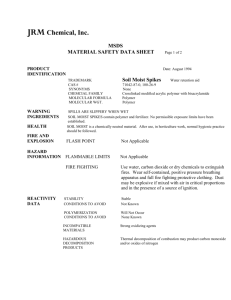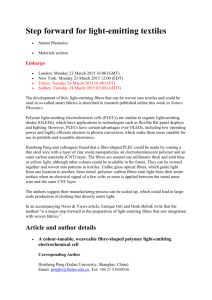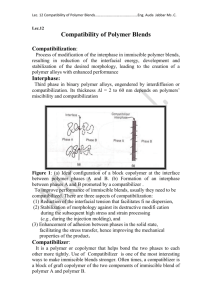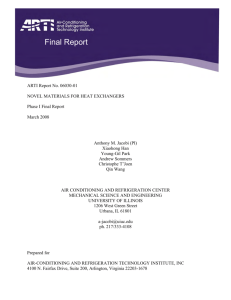NSF REU Site Renewal: Interfaces and Surfaces Summer 2015
advertisement
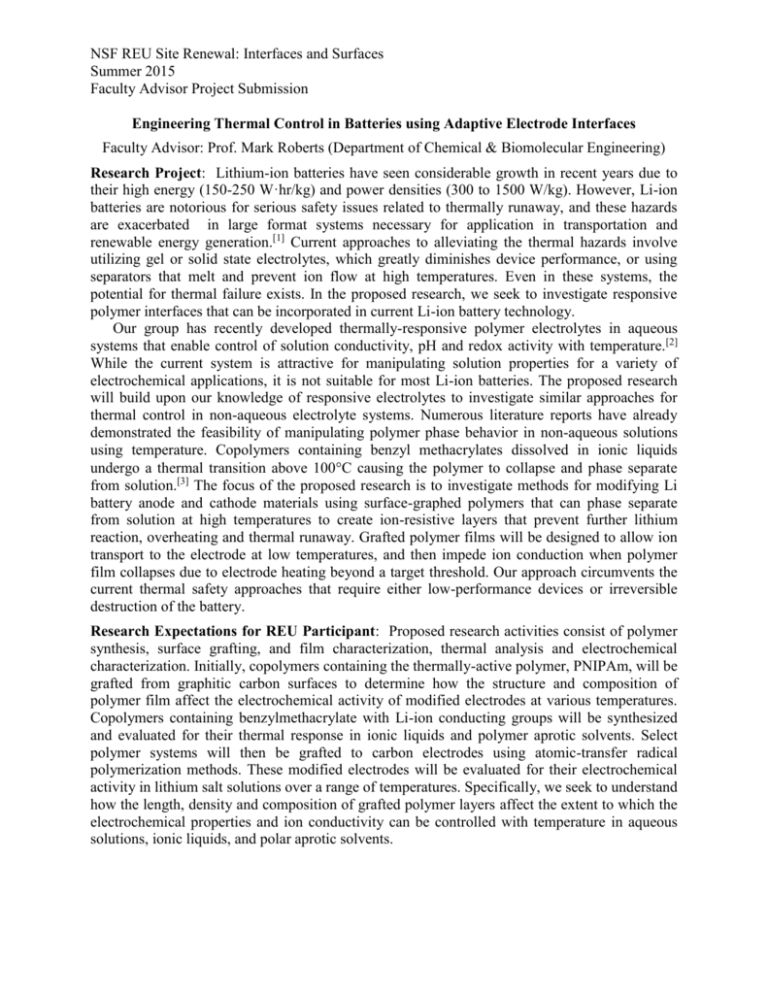
NSF REU Site Renewal: Interfaces and Surfaces Summer 2015 Faculty Advisor Project Submission Engineering Thermal Control in Batteries using Adaptive Electrode Interfaces Faculty Advisor: Prof. Mark Roberts (Department of Chemical & Biomolecular Engineering) Research Project: Lithium-ion batteries have seen considerable growth in recent years due to their high energy (150-250 W·hr/kg) and power densities (300 to 1500 W/kg). However, Li-ion batteries are notorious for serious safety issues related to thermally runaway, and these hazards are exacerbated in large format systems necessary for application in transportation and renewable energy generation.[1] Current approaches to alleviating the thermal hazards involve utilizing gel or solid state electrolytes, which greatly diminishes device performance, or using separators that melt and prevent ion flow at high temperatures. Even in these systems, the potential for thermal failure exists. In the proposed research, we seek to investigate responsive polymer interfaces that can be incorporated in current Li-ion battery technology. Our group has recently developed thermally-responsive polymer electrolytes in aqueous systems that enable control of solution conductivity, pH and redox activity with temperature.[2] While the current system is attractive for manipulating solution properties for a variety of electrochemical applications, it is not suitable for most Li-ion batteries. The proposed research will build upon our knowledge of responsive electrolytes to investigate similar approaches for thermal control in non-aqueous electrolyte systems. Numerous literature reports have already demonstrated the feasibility of manipulating polymer phase behavior in non-aqueous solutions using temperature. Copolymers containing benzyl methacrylates dissolved in ionic liquids undergo a thermal transition above 100C causing the polymer to collapse and phase separate from solution.[3] The focus of the proposed research is to investigate methods for modifying Li battery anode and cathode materials using surface-graphed polymers that can phase separate from solution at high temperatures to create ion-resistive layers that prevent further lithium reaction, overheating and thermal runaway. Grafted polymer films will be designed to allow ion transport to the electrode at low temperatures, and then impede ion conduction when polymer film collapses due to electrode heating beyond a target threshold. Our approach circumvents the current thermal safety approaches that require either low-performance devices or irreversible destruction of the battery. Research Expectations for REU Participant: Proposed research activities consist of polymer synthesis, surface grafting, and film characterization, thermal analysis and electrochemical characterization. Initially, copolymers containing the thermally-active polymer, PNIPAm, will be grafted from graphitic carbon surfaces to determine how the structure and composition of polymer film affect the electrochemical activity of modified electrodes at various temperatures. Copolymers containing benzylmethacrylate with Li-ion conducting groups will be synthesized and evaluated for their thermal response in ionic liquids and polymer aprotic solvents. Select polymer systems will then be grafted to carbon electrodes using atomic-transfer radical polymerization methods. These modified electrodes will be evaluated for their electrochemical activity in lithium salt solutions over a range of temperatures. Specifically, we seek to understand how the length, density and composition of grafted polymer layers affect the extent to which the electrochemical properties and ion conductivity can be controlled with temperature in aqueous solutions, ionic liquids, and polar aprotic solvents. NSF REU Site Renewal: Interfaces and Surfaces Summer 2015 Faculty Advisor Project Submission Figure 1. (A) Surface grafting approach to carbon surfaces using atom-transfer radical polymerization. (B) Thermal response of poly(benzylmethacrylate) polymers in ionic liquids.[3] [1] [2] [3] Biensan, P. et al., J. Power Sources 81-82, 906-912 (1999). J.C. Kelly, M. Pepin, D.L. Huber, B.C. Bunker, M.E. Roberts, Adv. Mater., 2012, 24, 886. T. Ueki, M. Watanabe, Langmuir, 2007, 23, 988–990.







